Table of Contents
- Cognitive Behavioral Therapy for Pornography Addiction
- CBT as a Therapeutic Framework for Pornography Addiction
- Mechanisms of CBT in Pornography Addiction Treatment
- Applications of CBT in Pornography Addiction Treatment
- Effectiveness of CBT in Pornography Addiction Treatment
- CBT with Other Treatments for Pornography Addiction
- Future Directions for CBT in Treating Pornography Addiction
- Conclusion
Cognitive Behavioral Therapy for Pornography Addiction
Cognitive Behavioral Therapy (CBT) for porn addiction has emerged as a crucial therapeutic approach in 2025, recognized for its structured, goal-oriented methodology in addressing the cognitive and behavioral patterns associated with problematic pornography use. CBT operates on the premise that individuals can modify their thoughts and behaviors to promote healthier coping mechanisms and mitigate the psychological triggers that lead to compulsive pornography consumption. It has gained considerable attention for its effectiveness in enhancing recovery outcomes, with research indicating that approximately 67% of participants experience significant improvements when engaged in CBT.
Notably, CBT employs various evidence-based techniques, including cognitive restructuring, behavioral activation, and relapse prevention strategies, to help individuals identify and challenge distorted beliefs about sexuality, relationships, and self-worth that may contribute to problematic porn use. By targeting irrational thoughts and reinforcing positive behaviors, CBT facilitates a deeper understanding of the emotional triggers linked to porn consumption, thus fostering long-term resilience against relapse. As a testament to its efficacy, studies have demonstrated that CBT can yield outcomes 15-26% superior to those achieved by individuals receiving minimal or no treatment, solidifying its status as a leading therapeutic modality for porn addiction. Despite its successes, the application of CBT for porn addiction presents unique challenges. Critics highlight the need for tailored interventions that address the distinctive aspects of porn addiction, particularly among digital natives and those with co-occurring mental health conditions.
Furthermore, the integration of digital health solutions and technology into CBT practices raises questions about accessibility, equity, and the inherent challenges of using technology-based interventions for a technology-mediated addiction. As ongoing research continues to explore these dynamics, the future of CBT in porn addiction recovery appears promising, aiming to enhance its adaptability and effectiveness across various treatment settings. In summary, CBT stands out as a robust framework for treating porn addiction in 2025, combining psychological insights with practical strategies to drive recovery. As the field evolves, continued focus on personalized treatment approaches and the integration of innovative technologies will be critical in expanding its reach and effectiveness, ultimately contributing to the long-term recovery of individuals struggling with problematic porn use.
CBT as a Therapeutic Framework for Pornography Addiction
Cognitive Behavioral Therapy (CBT) is a structured and goal-oriented form of psychotherapy that has emerged as a cornerstone in the treatment of pornography addiction. It operates on the principle that an individual’s thoughts, feelings, and behaviors are interconnected, and by addressing negative thought patterns related to pornography use, individuals can effectuate positive behavioral changes. This therapeutic approach is particularly effective in tackling the psychological aspects of problematic pornography use, enabling individuals to manage urges, enhance self-efficacy, and develop healthier coping mechanisms. CBT encompasses several evidence-based techniques, such as cognitive restructuring, which involves challenging and reframing irrational or harmful thoughts about sexuality, relationships, and self-worth. It also employs mindfulness strategies to increase awareness of emotional triggers and behavioral experiments to confront and manage compulsive viewing patterns.
The structured nature of CBT makes it suitable for both individual and group settings, facilitating diverse treatment modalities that cater to the unique needs of those struggling with porn addiction. Recent studies have highlighted the efficacy of CBT in pornography addiction recovery, with approximately 67% of individuals undergoing this therapy reporting significant improvements in their treatment outcomes. Furthermore, research indicates that CBT’s outcomes can be up to 15-26% better than those of individuals receiving minimal or no treatment, underscoring its effectiveness in addressing compulsive pornography use. As a result, CBT continues to evolve, integrating with other therapeutic approaches to create more individualized treatment plans that foster sustainable recovery and resilience against relapse, particularly in our increasingly digital world where access to pornographic content is widespread.
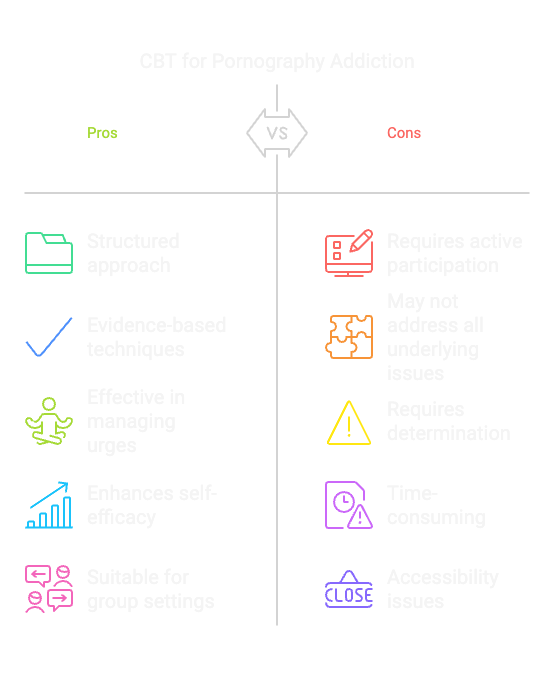
Mechanisms of CBT in Pornography Addiction Treatment
Cognitive Behavioral Therapy (CBT) employs various mechanisms that facilitate the treatment of pornography addiction by altering cognitive patterns and behaviors associated with compulsive viewing. These mechanisms are designed to empower individuals to manage their addiction effectively and promote long-term recovery in an increasingly digital world.
Cognitive Restructuring
One of the foundational mechanisms of CBT is cognitive restructuring, which focuses on identifying and challenging negative or distorted thoughts that contribute to problematic pornography use. This process involves recognizing automatic negative thoughts (ANTs) about sexuality, relationships, and self-worth, evaluating their validity, and replacing them with more balanced perspectives.
For instance, individuals may confront cognitive distortions such as “I can’t form real relationships” or “I need porn to cope with stress,” and learn to substitute these thoughts with healthier beliefs about intimacy and coping mechanisms.
Behavioral Activation
Behavioral activation is another essential mechanism within CBT that encourages engagement in meaningful activities to improve mood and reduce the likelihood of pornography use. Individuals are guided to identify fulfilling offline activities, develop real-world relationships, and set goals for participation, which helps to create a sense of accomplishment and genuine connection.
This mechanism is rooted in the understanding that increasing positive real-world experiences can counteract the isolating nature of pornography addiction and reduce the urge to seek comfort in digital sexual content.
Skill-Building and Coping Strategies
CBT emphasizes the development of practical coping skills that enable individuals to navigate digital triggers and urges without resorting to pornography use. Techniques such as urge surfing, mindfulness exercises, and healthy digital boundaries are taught to enhance emotional regulation and resilience.
These skills are practiced in real-life scenarios to build confidence and reinforce the ability to cope with online triggers and challenging emotions without turning to pornography.
Relapse Prevention
An integral part of the CBT framework is relapse prevention, which equips individuals with tools to manage urges and avert relapse in the digital environment. This includes identifying online triggers, developing digital wellness plans, and employing technical solutions like content blockers alongside psychological strategies. By enhancing self-efficacy and coping strategies, CBT supports individuals in maintaining their recovery journey in an internet-connected world.
Behavioral Experiments
Behavioral experiments play a vital role in CBT by allowing individuals to test and challenge their beliefs about pornography use in real-world situations. This process helps gather evidence against maladaptive thoughts about needing pornography, fostering a shift toward more adaptive beliefs and behaviors. Individuals engage in practical activities that encourage them to build healthy relationships and find satisfaction in non-pornographic activities.
Integration with Other Modalities
Ongoing research is exploring the integration of CBT with other therapeutic approaches, such as mindfulness-based interventions and digital wellness strategies. This combination aims to enhance the efficacy of pornography addiction treatment by addressing both psychological and technological aspects of recovery, providing a more comprehensive support system for individuals.
The ongoing investigation into the mechanisms of CBT continues to reveal insights into how it can effectively alter brain function related to impulse control and coping mechanisms for managing pornography urges and digital triggers.
Applications of CBT in Pornography Addiction Treatment
Cognitive Behavioral Therapy (CBT) has emerged as a highly effective intervention for pornography addiction, providing structured strategies to address the complex interplay between digital behavior, sexual compulsion, and psychological well-being. The primary focus of CBT is to understand and modify the thought patterns, emotions, and behaviors that contribute to problematic pornography use, thus empowering individuals to regain control over their digital lives and develop healthier relationship patterns.
Techniques Utilized in CBT for Pornography Addiction
CBT encompasses several techniques specifically designed to enhance recovery from pornography addiction:
1. Cognitive Restructuring Cognitive restructuring involves identifying and challenging distorted thoughts associated with pornography use. By replacing negative beliefs—such as “I need porn to feel good” or “I’ll never have a real intimate relationship”—with more constructive and realistic thoughts, individuals can alter their emotional responses and sexual behaviors. This process is crucial for developing a healthier relationship with sexuality and intimacy.
2. Coping Skills Training CBT emphasizes coping skills training specifically tailored to manage digital triggers and urges. Techniques include digital wellness strategies, mindfulness practices, and healthy relationship building. These skills help individuals develop alternatives to pornography use when feeling stressed, lonely, or aroused. Key components include:
- Digital boundary setting
- Stress management techniques
- Healthy intimacy building
- Communication skills for relationships
- Time management strategies
3. Relapse Prevention A key component of CBT in pornography addiction treatment is relapse prevention, which focuses on recognizing potential online triggers and developing proactive strategies to maintain recovery. This technique helps individuals:
- Identify high-risk situations in the digital environment
- Implement technical solutions (like content blockers)
- Develop emergency response plans for intense urges
- Create healthy daily routines that minimize exposure to triggers
- Build a support network for accountability
The integration of these techniques provides a comprehensive approach to addressing pornography addiction, acknowledging both its psychological underpinnings and its manifestation in our digital age. By combining cognitive restructuring with practical skills and relapse prevention strategies, CBT offers a robust framework for achieving and maintaining recovery from problematic pornography use.
Effectiveness of CBT in Pornography Addiction Treatment
Research indicates that CBT significantly improves recovery outcomes for individuals struggling with problematic pornography use. Studies evaluating CBT’s effectiveness in treating pornography addiction have demonstrated promising results, with success rates comparable to those seen in other behavioral addictions. Meta-analyses show that CBT interventions are approximately 15-26% more effective than minimal or no treatment approaches in reducing problematic pornography use and associated distress. Furthermore, research reveals that about 67% of participants undergoing CBT reported substantial improvements in their ability to manage compulsive viewing behaviors and develop healthier relationship patterns.
Real-World Applications
The application of CBT techniques in treating pornography addiction has shown particular effectiveness in addressing the complex interplay between digital behavior and psychological well-being. Studies have demonstrated that CBT not only helps reduce problematic pornography use but also effectively addresses co-occurring issues such as anxiety, depression, and relationship difficulties that often accompany pornography addiction. The therapy’s success in real-world settings is particularly noteworthy given the unique challenges of treating an addiction that involves readily accessible digital content. Key findings from clinical applications include:
- Significant reduction in time spent viewing pornography
- Improved relationship satisfaction and intimate functioning
- Enhanced ability to manage digital triggers and urges
- Better overall mental health outcomes
- Increased self-efficacy in maintaining healthy digital boundaries
- Sustained recovery rates when combined with ongoing support
These outcomes underscore CBT’s value as a primary treatment modality for pornography addiction, particularly when tailored to address the specific challenges of managing compulsive sexual behavior in our increasingly digital world.
Integration of CBT with Other Treatments for Pornography Addiction
Cognitive Behavioral Therapy (CBT) is increasingly recognized for its adaptability and effectiveness in treating pornography addiction, especially when integrated with other therapeutic modalities. This combined approach ensures holistic care that addresses both the psychological and behavioral aspects of compulsive pornography use.
Digital Interventions with TrueAlly
The TrueAlly app leverages CBT principles to empower individuals on their recovery journey. By incorporating daily check-ins, cognitive restructuring exercises, and mindfulness prompts, TrueAlly provides users with practical tools to address triggers and develop healthier coping mechanisms. The app’s learning modules and recovery calendar allow users to track progress and build resilience over time. TrueAlly also complements traditional CBT by offering digital accessibility, making it a valuable adjunct or stand-alone option for those reluctant to pursue in-person therapy.
Medication-Assisted Behavioral Therapy (MABT)
Although pharmacotherapy is less commonly applied to pornography addiction, integrating medications aimed at reducing compulsive behaviors with CBT techniques may enhance recovery outcomes. For example, SSRIs have been explored as a way to reduce impulsivity and hypersexual behavior. When paired with CBT, this approach equips individuals with the cognitive tools needed to manage urges effectively while addressing underlying neurochemical imbalances. Apps like TrueAlly can support this integration by reinforcing CBT strategies, such as thought journaling and goal setting, to enhance adherence and prevent relapse.
Group Therapy
Integrating CBT into group therapy for pornography addiction fosters a supportive environment where participants can share experiences and practice skills together. Group settings encourage open discussions about triggers, coping strategies, and progress, helping participants break the isolation often associated with pornography addiction. CBT-based techniques like mindfulness and emotional regulation are especially impactful in these sessions, promoting accountability and mutual encouragement. TrueAlly complements group therapy by offering features like progress tracking and motivational tools that participants can use independently between sessions.
Family Therapy
Pornography addiction often impacts family dynamics, making family therapy a crucial component of recovery. By integrating CBT into family therapy sessions, individuals and their loved ones can address communication breakdowns and unhealthy patterns that contribute to addiction. CBT helps families reframe negative thought processes and develop constructive ways to support recovery. TrueAlly reinforces these efforts by providing insights into behavior patterns and personalized strategies that can be shared during family sessions to enhance understanding and collaboration.
Peer Support Programs
Peer support programs, such as those based on 12-Step principles, are highly compatible with CBT. These programs offer a structured framework for accountability and shared learning, complementing CBT’s focus on goal-setting and behavioral modification. TrueAlly enhances this integration by serving as a digital ally, helping users implement CBT techniques like urge tracking and emotional self-regulation while fostering a sense of community through motivational content and reminders.
Future Directions for CBT in Treating Pornography Addiction
As we move toward 2025, significant trends and technological advancements are set to reshape the application of Cognitive Behavioral Therapy (CBT) in addressing pornography addiction. These innovations promise to enhance accessibility, effectiveness, and overall recovery outcomes, particularly when combined with digital platforms like the TrueAlly app.
Integration of Technology
Digital and Mobile Health Solutions
The rise of mobile health applications is making CBT more accessible, enabling individuals to engage in therapy from the comfort of their homes. Future advancements in digital CBT platforms, such as TrueAlly, will likely incorporate artificial intelligence (AI) to provide personalized therapy based on real-time user interactions. These tools will adapt therapeutic strategies dynamically, offering tailored exercises and interventions to meet users’ evolving needs. TrueAlly already sets the stage for this future with features like daily check-ins and recovery tracking, which provide actionable insights and immediate support.
Virtual Reality Therapy (VRT)
Virtual reality (VR) is poised to become a transformative tool in treating pornography addiction. Immersive VR environments can simulate triggering scenarios, allowing individuals to practice coping strategies in a safe and controlled setting. For example, users might engage with virtual experiences designed to test their responses to common triggers, enhancing their resilience and self-regulation. While still emerging, the potential integration of VR into apps like TrueAlly could elevate its capacity to offer interactive and effective therapeutic support.
Enhanced Personalization through AI and Machine Learning
AI and machine learning are transforming the personalization of CBT for pornography addiction. These technologies can analyze user behaviors and progress within platforms like TrueAlly, providing therapists or the app itself with data-driven insights to refine interventions. Predictive algorithms will identify which CBT techniques, such as cognitive restructuring or mindfulness exercises, are most effective for specific users, optimizing recovery outcomes.
Expansion to New Populations
CBT’s structured approach makes it adaptable for diverse populations, including those underserved or marginalized. Digital solutions like TrueAlly break down traditional barriers to therapy, such as stigma, transportation challenges, and scheduling conflicts, making treatment more accessible. As technology continues to advance, TrueAlly aims to expand its reach by offering multilingual support and culturally sensitive content to ensure inclusivity.
Long-term Benefits and Continued Research
Ongoing research is essential to refine CBT’s application for pornography addiction. Studies evaluating the long-term effectiveness of CBT techniques will guide the development of enhanced therapeutic strategies. TrueAlly contributes to this future by collecting anonymized user data (with consent) to better understand patterns in recovery and relapse, aiding both users and the broader mental health community in advancing evidence-based practices.
Conclusion
The future of CBT for pornography addiction is marked by technological integration, enhanced personalization, and expanded accessibility. Platforms like TrueAlly are at the forefront of this transformation, leveraging innovative features to empower individuals in their recovery journeys. As research and technology continue to evolve, CBT will remain a cornerstone of effective treatment, helping more individuals achieve lasting change in an increasingly connected world.
Sources
- Lotfi, A., Babakhanin, M., & Ghazanfarpour, M. (2021). The effectiveness of intervention with cognitive behavioral therapy on pornography: A systematic review protocol of randomized clinical trial studies. Health Science Reports, 4. https://doi.org/10.1002/hsr2.341.
- O’Cleirigh, C., Safren, S., Taylor, S., Goshe, B., Bedoya, C., Marquez, S., Boroughs, M., & Shipherd, J. (2019). Cognitive Behavioral Therapy for Trauma and Self-Care (CBT-TSC) in Men Who have Sex with Men with a History of Childhood Sexual Abuse: A Randomized Controlled Trial. AIDS and Behavior, 1-11. https://doi.org/10.1007/s10461-019-02482-z.
- Hofmann, S., Asnaani, A., Vonk, I., Sawyer, A., & Fang, A. (2012). The Efficacy of Cognitive Behavioral Therapy: A Review of Meta-analyses. Cognitive Therapy and Research, 36, 427-440. https://doi.org/10.1007/s10608-012-9476-1.
- Yusop, Y., Husin, M., Zainudin, Z., Othman, W., Harun, M., Sumari, M., & Ghafar, N. (2021). How Cognitive Behavioural Therapy Helps on Addictive Behaviour?. International Journal of Academic Research in Business and Social Sciences. https://doi.org/10.6007/ijarbss/v11-i12/11836.
